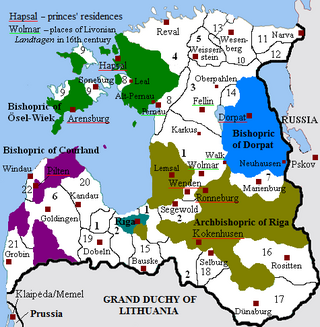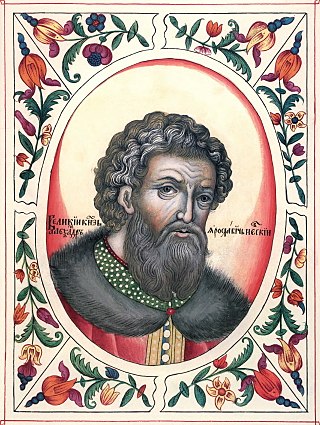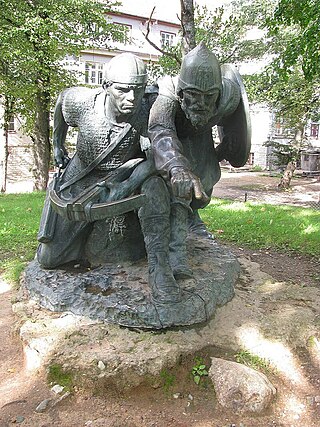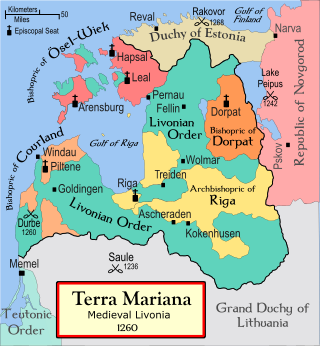
Livonia or in earlier records Livland, is a historical region on the eastern shores of the Baltic Sea. It is named after the Livonians, who lived on the shores of present-day Latvia.

The Northern Crusades or Baltic Crusades were Christianization campaigns undertaken by Catholic Christian military orders and kingdoms, primarily against the pagan Baltic, Finnic and West Slavic peoples around the southern and eastern shores of the Baltic Sea.

Alexander Yaroslavich Nevsky was Prince of Novgorod, Grand Prince of Kiev (1246–1263) and Grand Prince of Vladimir (1252–1263).

The Livonian Chronicle of Henry is a Latin narrative of events in Livonia and surrounding areas from 1180 to 1227. It was written c. 1229 by a priest named Henry. Apart from some references in Gesta Danorum – a patriotic work by the 12th-century Danish historian Saxo Grammaticus – and few mentions in the Primary Chronicle compiled in Kievan Rus', the Chronicle of Henry is the oldest known written document about the history of Estonia and Latvia.

The Battle on the Ice, also known as the Battle of Lake Peipus or Battle of Lake Chud, took place on 5 April 1242. It was fought on or near the frozen Lake Peipus when the united forces of the Republic of Novgorod and Vladimir-Suzdal, led by Prince Alexander Nevsky, emerged victorious against the forces of the Livonian Order and Bishopric of Dorpat, led by Bishop Hermann of Dorpat.
Ugaunians or Ugannians, referred to as Chudes by the earliest Russian chronicles, were a historic Finnic people inhabiting the southern Estonian Ugandi County that is now Tartu, Põlva, Võru and Valga counties of Estonia.

Ugandi was an independent county between the east coast of Lake Võrtsjärv and west coast of Lake Pskov, bordered by Vaiga, Mõhu, Nurmekund, Sakala, Tālava, and The Principality of Pskov. Ugandi had an area of approximately 3000 hides. Ugandi corresponded roughly to the present Estonia's territory of Võru County, Põlva County and half of Tartu County and Valga County, as well as Petseri County.

Vyachko, also known as Vetseke, was the prince of Koknese (Kuikenos). He later became the prince of Yuryev while in the service of Novgorod, which was the last Russian stronghold in Estonia. He died during the defense of the city against the Livonian Brothers of the Sword in 1224.

The Swedish–Novgorodian Wars were a series of armed conflicts during the 12th and 13th centuries, fought between the Novgorod Republic and medieval Sweden over control of the Gulf of Finland. Part of the trade route from the Varangians to the Greeks, the area was vital to the Hanseatic League. The clashes between Catholic Swedes and Orthodox Novgorodians had religious overtones, but before the 14th century there is no knowledge of official crusade bulls issued by the pope.

Daumantas, Domantas or Dovmont was Prince of Pskov from 1266 to 1299. During his term in office, Pskov became de facto independent from Novgorod.

The Battle of Wesenberg, Rakvere or Rakovor was fought on 18 February 1268 between the combined forces of Danish Estonia, the Bishopric of Dorpat, the Livonian Order, and local Estonian militias on one side, and the forces of Novgorod and Pskov, led by Dmitry of Pereslavl, on the other. Medieval accounts of the battle vary with both sides claiming victory; however, the Livonian victory is seen as more plausible as Novgorodian-Pskovian forces retreated out of Danish Estonia, with Livonian Knights launching a retaliatory attack on Izborsk and Pskov soon afterward, in June 1269.

The Livonian crusade consists of the various military Christianisation campaigns in medieval Livonia – modern Latvia and Estonia – during the Papal-sanctioned Northern Crusades in the 12th–13th century. The Livonian crusade was conducted mostly by the Holy Roman Empire and the Kingdom of Denmark. It ended with the creation of Terra Mariana and the Danish duchy of Estonia. The lands on the eastern shores of the Baltic Sea were one of the last parts of Europe to be Christianised. The available information is largely based on Livonian Chronicle of Henry.
Otto von Lutterberg was the Landmeister of the Livonian Order of the Teutonic Knights from 1267 to 1270.
The Pskov Land was a historical region in the north-west of medieval Russia centred around the city of Pskov. It was a vassal state of various Rus' states and had a measure of independence as Pskov Republic before being annexed by the Grand Duchy of Moscow. It had an important role in the trade and conflicts between Russia and its western neighbours.

Novgorodian Land was one of the largest historical territorial–state formations in Russia, covering its northwest and north. Novgorod Land, centered in Veliky Novgorod, was in the cradle of Kievan Rus' under the rule of the Rurikid dynasty and one of the most important princely thrones of the era. During the collapse of Kievan Rus' and in subsequent centuries, Novgorod Land developed as the Novgorod Republic: an autonomous state with republican forms of government under the suzerainty of the great princes of Vladimir-Suzdal. During the period of greatest development, it reached north to the White Sea, and in the east it has been claimed that it did spread beyond the Ural Mountains. It had extensive trade relations within the framework of the Hanseatic League and with the rest of Rus'. The Principality of Moscow conquered the Novgorod Republic in 1478, and annexed it in 1578, although Novgorod Land continued to exist as an administrative unit until 1708.

Terra Mariana was the formal name for Medieval Livonia or Old Livonia. It was formed in the aftermath of the Livonian Crusade, and its territories were composed of present-day Estonia and Latvia. It was established on 2 February 1207, as a principality of the Holy Roman Empire, and lost this status in 1215 when Pope Innocent III proclaimed it as directly subject to the Holy See.

The economy of the Pskov Republic (1348–1510) was dominated by merchants trading to and from the city of Pskov and the associated Pskov Land, primarily via the river Velikaya and connected waterways. It also had well-developed farming, fishing, blacksmithing, jewellery-making and construction industries.
Baldwin of Alna was an envoy and later a papal legate of Pope Gregory IX in the Baltic region. He played a diplomatic role in both the Northern Crusades and the Barons' Crusade.

The Danish campaigns to Novgorod were a series of Crusader raids in 1241 by Danish royals and vassals, using the Duchy of Estonia as base of operation, against the Novgorod Republic. The Danish Crusades were supported and executed in coordination with the papacy and other Crusading states, notably Sweden and the Livonian Order, the former one not being able to send further support after being defeated at the Neva.















